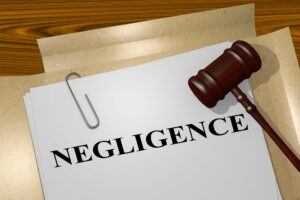Posted in Personal Injury on October 12, 2023

However, at Heenan & Cook in Montana, we firmly believe that the law should be accessible to everyone, regardless of their background or legal expertise. That’s why we’ve made it our mission to simplify these intricate concepts and present them in a way that’s easy to digest.
In this blog post, we will focus on negligence in law. Negligence, although fundamental, often appears shrouded in legalese, leaving many bewildered. We aim to change that-let’s get started.
What Is Negligence?
Negligence, in its simplest form, is all about responsibility and care. It’s a crucial concept in the law, but we can break it down into everyday language.
Imagine you’re playing catch with a friend. When your friend throws the ball, you expect them to throw it safely so you can catch it without getting hurt. That expectation is like a “duty of care” in the legal world. It means people should act responsibly and not do things that might harm others.
Now, let’s say your friend throws the ball really hard, and it accidentally hits you in the face, causing some bruises. In this situation, your friend didn’t meet the “duty of care.” They were careless, and that’s where negligence comes in.
Negligence is when someone doesn’t act as carefully as they should, and their actions end up causing harm to someone else. It’s like saying they made a mistake that hurt someone.
The Elements of Negligence
Understanding negligence in law involves grasping its key components, often referred to as the “elements of negligence.” Think of these elements as building blocks that help us evaluate whether someone acted carelessly and should be held responsible for the harm caused to another person.
Let’s delve into these elements in a way that’s easy to digest.
Duty of Care
This is the first building block. Imagine it as a signpost that says, “Be Careful Here.” It means that in certain situations, people have a legal obligation to act reasonably and avoid causing harm to others.
For instance, when driving a car, there’s a duty to obey traffic rules and drive safely. Negligence in this scenario may result in an auto accident lawsuit.
Breach of Duty
Think of this as the moment someone ignores the signpost and acts carelessly. To prove negligence, we need to show that the person didn’t meet the standard of care expected under the circumstances. For example, if a driver speeds and runs a red light, they are in breach of duty of care.
Causation
This part links the carelessness to the harm that occurred. It’s like connecting the dots. We have to demonstrate that the person’s carelessness directly led to the harm.
If the driver who ran the red light caused a car crash, it’s clear that their actions directly caused the accident.
Damages
Finally, we need to show that real harm or damage resulted from the carelessness. Imagine this as the “ouch” moment. It could be physical injuries, emotional distress, or financial losses.
For instance, if the car crash led to injuries and medical bills, that’s the damages part of negligence.
When these pieces come together in a way that shows someone didn’t act carefully and caused harm, that’s when we can say that negligence has occurred. It’s a way to make sure people take responsibility for their actions and take care not to harm others.
Examples of Types Negligence
To better illustrate the concept of negligence, let’s explore a few common scenarios. These include car accidents, slip and fall cases, and medical malpractice.
Car Accidents
Imagine a driver runs a red light and collides with another vehicle, causing injuries to the occupants. In this scenario, the driver who ran the red light could be considered negligent for failing to obey traffic laws and exercise caution. Speak to our team to learn what to do in a hit and run.
Slip and Fall Cases
Here, imagine a store owner who neglects to clean up a spilled liquid promptly. Then, a customer slips on the wet floor and sustains injuries. In this case, the store owner may be held negligent for not maintaining a safe environment.
Medical Malpractice
If a healthcare professional fails to provide the standard of care expected in their field, resulting in harm to a patient, they may be liable for medical negligence.
Legal Consequences of Negligence
When someone is found negligent and responsible for causing harm or damage to another party, they may be required to compensate the injured party. This compensation can cover medical expenses, lost wages, pain and suffering, and other losses incurred due to the negligence.
It’s important to note that negligence cases can vary in complexity, and the outcome depends on the specific facts and circumstances of each case. If you believe you have a negligence claim, such as a car accident lawsuit, it’s crucial to consult with legal professionals like Heenan & Cook in Montana to evaluate your situation and determine the best course of action.
Preventing Negligence
While understanding negligence is essential for legal matters, it’s equally important to take steps to prevent negligence in your own actions. Here are some practical tips
Be Aware
It’s important to always pay attention to your surroundings and actions. Avoid distractions, especially when driving or engaging in potentially risky activities.
Follow Safety Guidelines
Whether at home, work, or in public places, be sure to adhere to safety guidelines and regulations. This includes obeying traffic laws, using safety equipment, and maintaining a safe environment.
Seek Professional Advice
If you’re unsure about the level of care or precautions required in a specific situation, consult with experts or professionals who can provide guidance.
Understanding Negligence in Law
In summary, negligence in law is a concept that revolves around the failure to exercise reasonable care, leading to harm or damage to others. Understanding the four elements of negligence-duty of care, breach of duty, causation, and damages-can help clarify this complex legal principle.
At Heenan & Cook in Montana, we are your premier personal injury attorney in Montana. Contact us today for a free case evaluation.


